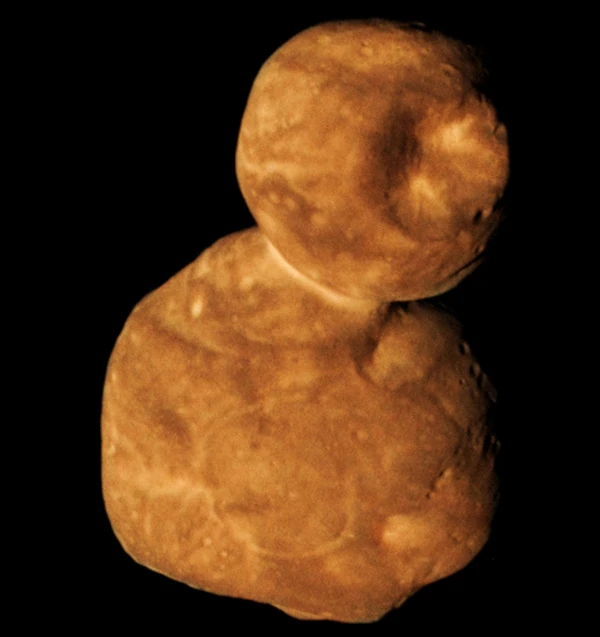
Description of the image: Arrokoth, the red snowman, is a contact binary object. Discovered in 2014 by the Hubble Space Telescope, this object was flown by NASA's New Horizons probe on January 1, 2019.
Arrokoth, nicknamed "Ultima Thule," is a trans-Neptunian object (TNO) located in the Kuiper Belt, populated with icy objects beyond Neptune, such as Pluto, Haumea, Albion, or Varuna. Its orbit, relatively circular, is located about 6.5 billion kilometers from the Sun (44 AU). Its orbital period around the Sun is about 298 years.
Arrokoth's surface is reddish, similar to other Kuiper Belt objects, due to the presence of tholins—complex organic compounds formed by the irradiation of simple compounds like methane and ethylene. This coloration suggests that Arrokoth's surface is the result of chemical processes caused by continuous exposure to cosmic rays and UV radiation from the primordial space environment.
Observations from New Horizons indicate that Arrokoth is a preserved object from the formation of the solar system. Its surface is surprisingly smooth and shows few craters, suggesting it has undergone few collisions since its formation. The relatively uneventful geological history may have preserved characteristics from the time of its formation.
Density analysis indicates that it is probably composed of ices and porous rocks, with an average density of about 0.5 g/cm³, which is lower than that of water. Arrokoth is not a rock whose density ranges between 2.5 and 3 g/cm³. Its composition indicates a formation under low-energy conditions.
Arrokoth consists of two distinct lobes. The larger lobe, nicknamed "Ultima," is about 21 kilometers in diameter, while the smaller one, "Thule," is about 15 kilometers in diameter. The two lobes are connected by a narrow "neck," giving the object a "snowman" appearance.
Arrokoth is an example of a contact binary, formed when two distinct objects "stuck" together at low speed. This gentle formation contrasts with the violent collisions that form many other objects in the solar system.
Formation models indicate that this gentle accretion occurred in the primordial solar nebula. Data from New Horizons show that Arrokoth's lobes are aligned, suggesting that they formed separately but in close orbit around each other before merging. This configuration is consistent with a low-energy impact, reinforcing the idea of formation in a calm environment, long before the collapse of the primordial cloud.
Arrokoth is considered a primitive object, preserved since the formation of the solar system. Studying its physical characteristics provides a unique window into the initial conditions of the solar nebula. Unlike other objects that have undergone significant transformations, Arrokoth has remained relatively unchanged, making it particularly valuable to scientists. Arrokoth's astonishing characteristics provide valuable information on the formation processes and evolution of small bodies, which progressively aggregated to form larger bodies called planetesimals.